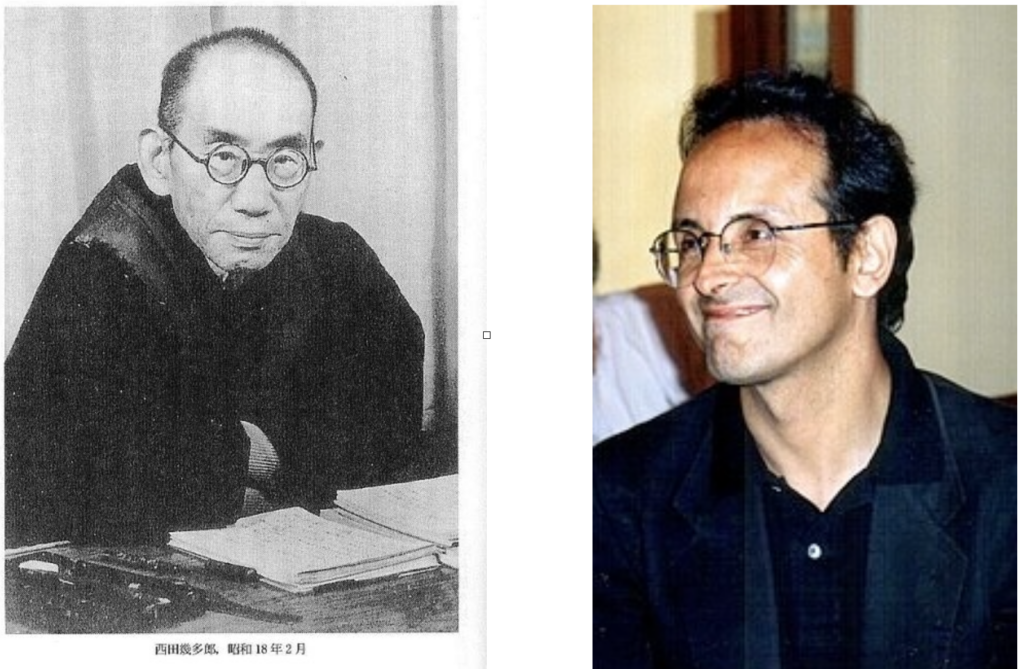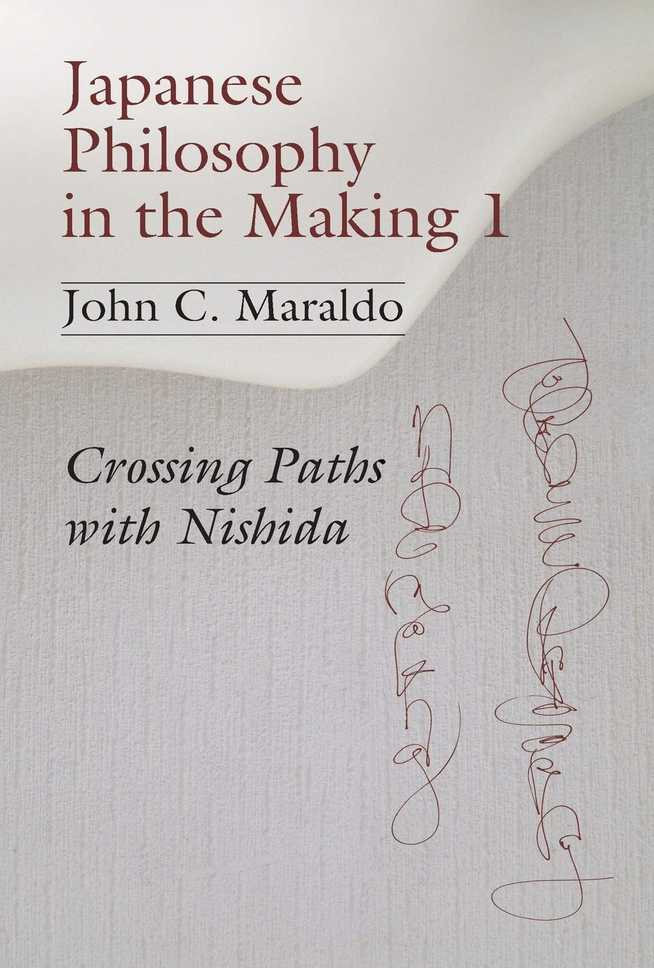“In the position I am articulating, the self is to be understood as existing in that dynamic dimension wherein each existential act of consciousness, as a self-expressive determination of the world, simultaneously reflects the world’s self-expression within itself and forms itself through its own self-expression … “That I am consciously active means that I determine myself by expressing the world in myself” (Nishida Kitaro, “The Logic of the Place of Nothingness and the Religious Worldview,” Last Writings, 64).
“The new [cognitive science] explains cognition in terms of circulation: cognition arises in a circuit, a coupling or a loop between an organism and an environment. Each part of the loop is active and contributes to the whole. On the side of the organism, “perception and action are fundamentally inseparable in lived cognition” (Varela) … Actions affect the environment that, in turn, provides not only of what commonly counts as the knowing subject but also of what counts usually as the known world. Neither is a pre-given and independent reality. Rather, both knower and world are enacted” (John Maraldo, Japanese Philosophy in the Making 1).

Third-person perspective and first-person perspective
In Inquiry into the Good, Nishida Kitaro (1870-1945) apprehends the world from the side of experience, seeking a “pure experience” of reality, “to know facts just as they are, to know in accordance with facts by completely relinquishing one’s own fabrications … by pure I am referring to the state of experience just as it is without the least addition of deliberative discrimination (Inquiry, 3). Nishida’s inquiry first elucidates it as “intellectual intuition” and, in subsequent works, develops it to finally arrive at the concept of “action-intuition” (koi-teki chokkon) “which shifts the cognitive process from its base in the human subject to that of a self-determination of reality through human consciousness which at once allows humans to know themselves.” Nishida’s philosophy has been called an “experiential ontology,” where the word ontology refers to the process of coming into being, and not as “on” the specific Greek metaphysical conflation between Plato’s Ideas and “what is” as the foundation for our lives now known as the “correspondence theory of language.”
Francisco Varela (1946-2001) is well-known in Buddhist circles as the co-founder of the Mind and Life Institute, and the co-author, with Evan Thompson and Eleanor Rosch, of The Embodied Mind: Cognitive Science and Human Experience. His academic background, however, was in biology: he was a Chilean biologist, philosopher, cybernetician, and neuroscientist who, together with his mentor Humberto Maturana, is best known for introducing the concept of autopoiesis to biology. Varela did become familiar with Tibetan Buddhism, which he studied with Keun-Tshen Goba (né Ezequiel Hernandez Urdaneta), Chögyam Trungpa Rinpoche, and later Tulku Urgyen Rinpoche. Still he ended his academic career as a professor of biology at the University of Chile.
Because of his familiarity with Buddhism and his interest in neuroscience and philosophy, Varela was, in John Maraldo’s words, “pivotal” in a shift that occurred in the 1970s in the study of human cognition “away from ‘computationalist’ computer models to more holistic biological models … As opposed to the emphasis in philosophy on propositional knowledge, or ‘knowing that such and such is the case’, the new cognitive science emphasizes ‘knowing how’, as it is expressed directly in action. Its aim was ‘to anchor research to the real world poles of sensing and acting. Thus anchored, time, world and body emerge as significant players in the cognitive arena. The parallels with Nishida’s koi-teki chokkan are striking’.”
As a scientist, Varela approached reality from the third-person perspective wherein the world is seen from the standpoint of “objectivist” discriminative consciousness as it appears to be in front of us, separate from us. Nishida, on the other hand, approached reality from the first-person perspective, in fact, the “no-person” perspective (since he is writing from the standpoint of “no-mind”), ”as experienced, in search of a world before naming had occurred. Maraldo, however, says that “the new cognitive science also aims to take into account first-person, phenomenological perspectives; it incorporates the work of phenomenologists like Merleau-Ponty and Heidegger, and is sometimes informed by Buddhist philosophy. The new approach is also reflexive in that it requires cognitive scientists to apply it to themselves and their own activities. These aspects provide common ground with Nishida’s thinking.”
Cognition as a circuit, a coupling or a loop between an organism and an environment

Maraldo notes that “Nishida uses the term cognition only occasionally and in a more narrow sense than knowing, yet his sense of ‘knowing without a knower’ is comparable to the notion of non-conscious cognition in the new cognitive science … Its general thesis states that cognition is an accomplishment requiring bodily structures that interact with the surrounding world and in turn are reshaped by it. All cognition is grounded in action, more precisely in interactions between an organism and its surrounding world.”
Maraldo continues, “the new approach explains cognition in terms of circulation: cognition arises in a circuit, a coupling or a loop between an organism and an environment. Each part of the loop is active and contributes to the whole. On the side of the organism, ‘perception and action are fundamentally inseparable in lived cognition’ (Varela) … Actions affect the environment that, in turn, provides not only of what commonly counts as the knowing subject but also of what counts usually as the known world. Neither is a pre-given and independent reality. Rather, both knower and world are enacted.”
Enaction
Maraldo explains: “Enaction is the term used by Varela and others to denote the manner in which cognition works. Cognition first of all brings forth, interdependently, both a world and a knowing self, and only then can knowing selves articulate what is known in a set of propositions. The ‘body of knowledge’ that cognition creates is not first of all a system of propositional knowledge but rather a concrete, human body that knows things by interacting with them. As things in the world affect the way the body perceives, moves, and handles them, they in turn shape sensorimotor and neural patterns that re-define the body. And as the acting and cognizing body moves and modifies the things in the world, it re-creates its environment. Body and surrounding world are brought forth in an ‘enactment’. Furthermore, the enacting that describes cognition in general is a form of practice: sensorimotor actions are learned and repeated in real-life situations until their performance becomes second nature. Actions generate recurrent patterns.”
Maraldo illustrates how Varela’s cognitive system works with the example of the enactment of the world of color: “Colors result from the interaction of at least five factors: 1) light reflected off things together with 2) the ambient surrounding light, both dependent upon 3) the angle of perception of a mobile body, 4) the neural patterns formed previously in the body’s history of color perception. In short, the world of color is enacted.” In Varela’s words, “The world is not something that is given to us but something that we engage in by moving, touching, breathing, and eating. This is what I call cognition as enaction, since enaction connotes this bringing forth by concrete handling.”
Coincidentally, Nishida also illustrates his own argument with an example involving colors, but it is quite different. Nishida says that “intellectual intuition,” includes “the structure of the relationship,” that is, that the color red necessarily arises at the same time as the universal called “color.” “If red were the only color, it would not appear to us as such, because for it to do so there must be colors that are not red. Moreover, for one quality to be compared with and distinguished from another, both qualities must be fundamentally identical; two things totally different with no point in common cannot be compared and distinguished.” For instance the color red and the shape of a square. “If all things are established through such opposition, then there must be a certain unifying reality concealed at their base” (Inquiry, 56). This unity concealed at the base of all colors is the universal called “color.” And this universal has to be “empty” of color for it to accommodate all colors. Whereas Varela thinks in terms of the physical body, as interpreted in modern Western biology, Nishida turns to grammar and epistemology to expound what he called a “logic of the predicate.” In the words of Robert Carter in his book on Nishida, “What is primary in the judgment ‘red is a color’, is not the grammatical subject … the real subject of the sentence ‘red is a color’ is not ‘red’, nor even the grammatical predicate ‘color’, but the system of colors itself. To have a concept of ‘red’ is already to have a concept of colors. Of course, the system, like ‘color’ itself, has no color.” (Carter, 27). Nishida later developed this predicate logic into a field theory wherein “Color is a ‘field’ in which specifications arise … A field-theory takes the background as the real foreground, the real subject … It is an intuition, a given of experience or conception of which individual instances are but partial articulations” (Carter, 29).
Varela shares this concept of field theory when he writes: “When we consider the acting, cognizing body and the world both as parts of a living system, it can be said that the system generates meaning for itself. The proposal resonates with Nishida’s ideas, expressed in more idealist and mathematical language, that the world reflects itself in itself. But instead of Nishida’s language of the ‘self-determination of the universal’ with the bodily self as “a focal point of the world,” cognitive science speaks of the specifications of the living system that come about through the body’s perspectival actions.”
The Body as a Historical Being
Varela also specifically uses the word “historical” in connection with the “cognizing body.” Maraldo writes: “The new cognitive science, moreover, explicitly speaks of the body as historical. The cognizing body is itself formed through its previous interactions in a shared biological and cultural world … The cognitive self is its own implementation: its history and its actions are of one piece” (Varela). Varela speaks of an “embodied history” and writes that the constitution of the cognitive agent is “neither strictly determined nor planned”; rather it is “a matter of the commonsensical emergence of an appropriate stance from the entire history of the agent’s life” (Varela). “A broader biological, psychological and cultural context defines the body’s sensorimotor capacities (Varela, Thompson & Rosch).”
Where cognitive science elaborates and clarifies Nishida
Nishida and Varela are sufficiently close for Maraldo to switch to the term “enactive intuition” when he talks about Nishida. He does, however, point out a significant difference between the two: “Nishida’s notion seems more restrictive than the general kind of cognition explained in cognitive science.” Nishida did not explain how “reflective, propositional knowledge arises from … direct [intuitive] apprehension. He attempted an explanation in his first work, Inquiry into the Good, where he proposed that pure experience and intellectual intuition also underlie judgments that specify a subject and an object. The immediate perception of a running horse, for example, underlies the reflective judgment, ‘the horse is running’.” But Nishida does not “show how enactive intuition gives rise to propositional knowledge … and provides the foundation of scientific knowledge … The new cognitive science, on the other hand, shows in detail how actions are guided by perception and initiate new perceptions, and how such actions give rise to abstract concepts and eventually to the proposition knowledge derived from them. Nishida’s selection of examples of the enactive intuition at work in artistic creation and other instances of ‘knowing without a knower’ reflect this restricted viewpoint.” To a point, Nishida’s insight is still shaped by his early experience of “immersion or absorption into a thing and becoming it.” But, at the same time, he has “misgivings about the immersion model of knowing.” Nishida’s later “notion of the historical, practical body, which sees or knows by way of action, seems better captured by the language of interaction.” On the other hand, “the new cognitive science is clear that enaction and thus cognition are matters not of immersion but of interactions between mutually defining, yet autonomous, beings. The case in Nishida is more ambiguous.”
Where Nishida challenges cognitive science
“For all that,” Maraldo writes, “the differences from Nishida that might support the new cognitive science also expose two interrelated ambiguities in it. The first concerns the ambiguous roles of agency and consciousness in the new cognitive science. The second reveals an ambiguity in Varela’s notion of the selfless self.”
Varela talks of an “action without an agent,” just as Nishida talks of a “knowing without a knower.” But at times Varela refers to “the agent as a multitude, a ‘society of agents’ operating within the individual body. These agents, or rather these tendencies to action, vie with one another until one wins out and a coordinated action is performed, Varela suggests.” And Varela also says that “the emergence of the sense of a single active self is actually inaccessible to introspection or to one’s own consciousness. This claim is in tension with his own view that the Buddhist practice of mindfulness brings to light the fragmentary, even illusory nature of self.”
As remarked before, even though Varela came to share insights with Buddhism, his standpoint with regards to reality remained that of a scientist: he saw the world from the objectivist standpoint of ordinary reflective consciousness, i.e., the discriminative mode of thinking, whereas Nishida saw it from the standpoint of no-mind, i.e., intuition. In other words, Maraldo explains, Nishida “is not stating a fact about the world.” Instead, he is “expressing a directive or imperative.” For Nishida, “the self as acting body is not only in the world but must transcend it, and does so in self-awareness. This transcendence-in-immanence allows the self to see or know itself, and provides the ground of a unique, historical self. Cognitive science recognizes no such transcendence that would allow for self-knowledge and knowledge of the world.” Despite his stated objective to be a “philosopher” in the secular Western sense of the term, rather than a “Buddhist philosopher,” Nishida de facto taught a practice for self-cultivation in the manner of a wisdom teacher. His last essay, “The Logic of the Place of Nothingness and the Religious Worldview,” which he wrote a few months before his death, shows him to have been thinking as a wisdom teacher all along. His texts are prescriptive rather than simply descriptive.
Nishida’s notion of non-self is performative, Varela’s is analytical
Before concluding, Maraldo points out that “there are two notions of nonself at work in Buddhism, only one of which plays a role in Nishida.” It is the “performative” notion of nonself. Varela’s notion of non-self is the earlier “analytical” notion found in Indian Buddhism.
The earlier definition of nonself is the analytical breakdown of the body-mind into the five skandhas found in the Abhidharmic philosophy, as well as, in Yogacara, the breakdown of consciousness into eight layers, including manas or ego-self. Maraldo says that “Varela explicitly refers to the theory of skandhas as a precursor of what cognitive science has discovered about the disunity of the subject and the illusion of a substantial self. This analytical sense of nonself,” he adds, “is partially in tension with what I will call a second, performative sense implied in Nishida’s works and explicit in much Zen literature. The performative sense is elicited through meditative practices that can result in a breakthrough to an awakening of nonself – or as Dogen would put it, that can manifest nonself through “practice-realization.” The performative notion is, however, implicit in Nishida’s well-known evocations of a seeing without without a seer, a knowing without a knower.“
Maraldo speculates that “the performative notion may also be implicit in the Buddha’s famous reply of silence to Vaccagotta’s metaphysical question of whether or not there existed an atman. The Buddha later remarked to his disciple Ananda that both an affirmative and a negative answer would be misleading, and so Buddhist traditions classified this metaphysical question along with others as incoherent (nopeti) or undecidable.”
It remains, however, that “Varela and his colleagues proposed three levels of mind behind the illusion of a single, subjective sense of self. Two are conscious: first, a person’s lived experience, immediate or directly present, if always mediated by interactions with the world, and second, the person’s reflective consciousness. Underlying these two is a deeper, sub-personal level of “nonconscious thought” that is inaccessible to consciousness but discoverable through empirical research. However, just how the enactive mind relates to an expressive, meaning-giving historical self is left relatively obscure.”
Conclusion
Maraldo’s blend of Nishida’s and Varela’s views with the translation of koi-teki chokkan as enactive intuition, shows him to be keen to emphasise what these have in common. Maraldo even says that he has suggested two more terms “action-oriented intuition” and “performative intuition.” Specifically, Maraldo defines koi-teki chokkan as follows: “Enactive intuition is the performance of an embodied individual who in turn is formed by the world. This vision of mutual interaction and formation differs widely from the assumptions that we know the world as detached selves and that we achieve selfhood by action on things in the world as independent, self-determining agents. In Nishida’s later philosophy, as in some cognitive science, there would be no world and no knowledge without enaction.”
Sources
Nishida Kitaro – An Inquiry into the Good (1911-translation 1987)
Nishida Kitaro, “The Logic of the Place of Nothingness and the Religious Worldview,” Last Writings (1945-translation 1987)
John C Maraldo – Japanese Philosophy in the Making 1 – Crossing Paths with Nishida (2017)
Robert E Carter – The Nothingness Beyond God – An Introduction to the Philosophy of Nishida Kitaro (1997)
